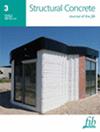Mechanical behavior of prestressed UHPC wind turbine tower columns under combined axial compression and bending
IF 3.3
3区 工程技术
Q2 CONSTRUCTION & BUILDING TECHNOLOGY
引用次数: 0
Abstract
Developing offshore wind power can effectively reduce carbon emissions, and adopting large‐capacity wind turbines is an important way to achieve cost reduction and efficiency increase. With increasing power capacity, the hub height and rotor‐nacelle assemblies (RNA) load will increase significantly. Ultra‐high performance concrete (UHPC) possesses ultra‐high compressive performance, good tensile, fatigue, and corrosion resistance, and thus is an effective way to further improve the mechanical performance and economic efficiency of tall offshore wind turbine (OWT) towers. Evaluation of ultimate strength is an essential aspect of design for OWT towers, and the tower structure is mainly under the combined action of axial compression from the self‐weight and RNA loads and bending from the eccentricities of RNA and aerodynamic loads from the rotor on the tower top. In this work, the mechanical behavior of prestressed UHPC wind turbine tower columns under combined axial compression and bending was numerically investigated. The finite element (FE) analyses were carried out using ABAQUS, and the material and geometric nonlinearity were considered in the model, as well as the tensile strain hardening properties of UHPC. The FE models were firstly verified by the typical experimental results of UHPC hollow columns, reinforced UHPC beams, prestressed UHPC beams, and prestressed concrete‐steel hybrid wind turbine tower model. Then the parametric study was carried out, and the parameters included the control stress and number of prestressing tendons, rib number, diameter‐to‐thickness ratio of the UHPC column, steel ratio of longitudinal reinforcement, axial load ratio, and UHPC strength. The calculation methods for flexural capacity of prestressed UHPC wind turbine tower columns were finally proposed, and were found to agree well with the modeling results.预应力超高性能混凝土风力涡轮机塔柱在轴向压缩和弯曲联合作用下的力学行为
发展海上风电可有效减少碳排放,而采用大容量风力涡轮机是实现降本增效的重要途径。随着发电量的增加,轮毂高度和转子-机舱组件(RNA)的负荷也将大幅增加。超高性能混凝土(UHPC)具有超高的抗压性能、良好的抗拉、抗疲劳和耐腐蚀性能,因此是进一步提高高大海上风力涡轮机(OWT)塔架机械性能和经济效益的有效途径。极限强度评估是海上风力涡轮机塔架设计的一个重要方面,塔架结构主要受到自重和 RNA 载荷的轴向压缩、RNA 偏心弯曲以及塔顶转子空气动力载荷的共同作用。在这项工作中,对预应力 UHPC 风力涡轮机塔柱在轴向压缩和弯曲联合作用下的力学行为进行了数值研究。使用 ABAQUS 进行了有限元(FE)分析,并在模型中考虑了材料和几何非线性以及 UHPC 的拉伸应变硬化特性。首先通过 UHPC 空心柱、加筋 UHPC 梁、预应力 UHPC 梁和预应力混凝土-钢混合风力涡轮机塔架模型的典型实验结果对有限元模型进行了验证。然后进行了参数研究,参数包括预应力筋的控制应力和数量、肋数、UHPC 柱的直径与厚度比、纵向钢筋的钢率、轴向荷载比和 UHPC 强度。最终提出了预应力 UHPC 风力涡轮机塔柱抗弯承载力的计算方法,结果与建模结果吻合良好。
本文章由计算机程序翻译,如有差异,请以英文原文为准。
求助全文
约1分钟内获得全文
求助全文
来源期刊

Structural Concrete
CONSTRUCTION & BUILDING TECHNOLOGY-ENGINEERING, CIVIL
CiteScore
5.60
自引率
15.60%
发文量
284
审稿时长
3 months
期刊介绍:
Structural Concrete, the official journal of the fib, provides conceptual and procedural guidance in the field of concrete construction, and features peer-reviewed papers, keynote research and industry news covering all aspects of the design, construction, performance in service and demolition of concrete structures.
Main topics:
design, construction, performance in service, conservation (assessment, maintenance, strengthening) and demolition of concrete structures
research about the behaviour of concrete structures
development of design methods
fib Model Code
sustainability of concrete structures.
 求助内容:
求助内容: 应助结果提醒方式:
应助结果提醒方式:


